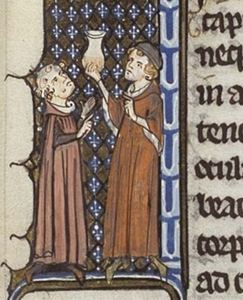By Marri Lynn (W&M Regular Contributor)
Recognizing that a medieval physician’s skills started with his ability to auger urine, many a patient chose to run diagnostic exams of their own. A ready litmus test was at hand: a sneaky game of pee-swap.
Prospective clients or ailing patients often sent an intermediary with ‘their’ urine in their stead, making it impossible for the doctor to see and assess the patient directly through other visible symptoms. Presented with a flask of mysterious liquid and the poker face of a healthy comrade of the ill, the physician was at risk of discrediting himself spectacularly.
The urine swap trick was intended as a test of a doctor’s learnedness, confidence, and powers of perception. For the patients concerned, good uroscopy skills in their physician, or lack thereof, could mean the difference between a precise diagnosis and helpful medication to follow, or a costly and potentially deadly blunder.
Arnau of Vilanova, a twelfth-century polymath and physician, was rather familiar and frustrated with these attempts to make fools of honourable physicians. In a tract on bedside manner, he laid out no less than nineteen itemized pieces of advice for addressing the commonest types of tricks, from the replacement of a patient’s urine with that of a relative’s of the opposite sex, to being confronted with animal urine or even white wine.
Arnau advises, first, to aim for the weakest link: the trickster himself, or the go-between who’s brought the urine forward. “You must look at him sharply and keep your eyes straight on him or on his face,” Arnau writes, “and if he wishes to deceive you he will start laughing or the color of his face will change…”
There is only one correct response for any physician affronted with such flagrant deception: “…you must curse him forever and in all eternity.”
Note well that the recommended admonishment for those who try to smuggle white wine in place of urine is, instead, “get away and be ashamed of yourself!”
More interestingly, Arnau advises that physicians should covertly sniff the suspect liquid by getting a small drop on the finger and then pretending to blow one’s nose. It’s curious that he suggests this subterfuge instead of advising his readers to openly sniff, quaff, or look at the liquid at length. Presumably Arnau didn’t trust that the appearances and odours of these random liquids would be obvious enough to every reader. Or perhaps the reputation of physicianhood had such high expectations (or honours?) upon it that a full, sommelier-like urine analysis was preferably not to be performed in front of prospective and dubious clients.
When confronted with a more poker-faced customer and a liquid more mysterious or less odious than wine, Arnau gave advice that would bring a smile to the face of Dr. Gregory House. To preserve the proper medical air of authority, the physician was instructed to ask leading questions in the hope the uneducated client would accidentally reveal the real source of the liquid. But if the answers were vague, or the individual donated false information to further trick the physician, Arnau instructed his peers to gain a little leverage and re-assert authority by using flashy medical terminology that would leave the client blinking in ignorance. That would, Arnau assured, put the upstart in his place and remind him that a physician’s intellect could not be tested by his ilk.
Arnau’s advice reveals more than just the frustrations and tactics of doctors attempting to avoid the pitfalls of patients engaging in a little research before purchase; here is evidence of the tenuous public position held by scholastic medicine’s truth-claims, as well as its effect on what constituted professional training. A physician couldn’t, or shouldn’t, rely on his knowledge of urines alone to combat patient subterfuge. Perception, deception, tact, and psychology went hand-in-hand with the uroscopy flask.
Marri Lynn holds an MA in the History of Medicine at McGill University, Montreal (2011). She is currently studying French, while freelancing as a writer and copy editor. You can find out more at her About.me page.

